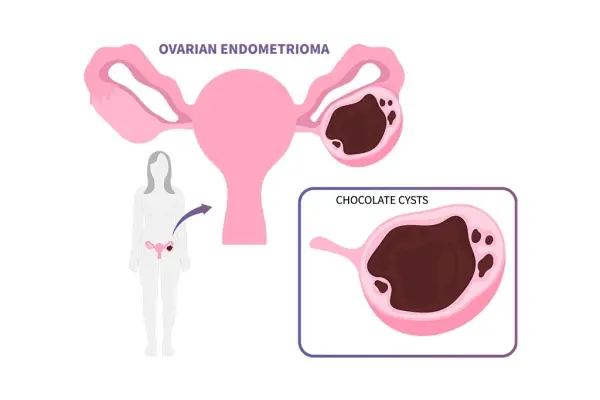What are chocolate cysts?
Endometriomas, scientifically termed chocolate cysts, earn their name from their dark and chocolate-like appearance. These ovarian cysts are a clear manifestation of endometriosis, a chronic condition marked by the abnormal growth of tissue resembling the uterine lining but outside the uterine cavity. This misplaced tissue reacts to hormonal shifts much like the normal endometrial tissue within the uterus. Consequently, it triggers inflammation and the development of cysts on the ovaries, creating a complex interplay of elements in the intricate landscape of a woman’s reproductive system. It is akin to a misguided symphony where the hormonal orchestra produces an undesirable melody, leading to discomfort and health challenges.
Who does it affect?
Endometriosis, and by extension, chocolate cysts, does not discriminate based on age but tends to make its presence known more frequently during the reproductive years of a woman’s life. Statistics suggest that approximately 10% of women in their childbearing age grapple with endometriosis, with a notable portion of them grappling with the manifestation of chocolate cysts. The age bracket of 25-40 is where this condition tends to assert itself more prominently. Acknowledging the prevalence and demographics empowers healthcare professionals to customise their approaches, ensuring tailored treatment plans that align with the distinct needs and risks of different age groups.
Causes of Chocolate Cyst
Understanding the causes of chocolate cysts involves a multifaceted exploration, including additional contributing factors. There are various theories proposed which explain the origin of endometriosis. One theory proposes that in some patients the menstrual blood flows in retrograde direction and enters the abdominal cavity leading to endometriosis. Another proposed possibility is that the tissue inside the abdominal cavity changes spontaneously to endometrial tissue due to unknown factors leading to the disease. Certain auto immune factors also might be playing a role in the development of the disease.
Symptoms of Chocolate Cyst
Beyond the primary symptoms, a more comprehensive understanding of the diverse manifestations can aid in timely identification. The primary symptoms of chocolate cysts are:
- Dysmenorrhea: [Painful menstruation] Painful menstruation is the most common primary symptom experienced. The pain is often very severe necessitating administration of pain killers.
- Back Pain: Discomfort may radiate to the lower back, affecting posture and contributing to back pain. This can be during menstrual cycle as well as independent of it.
- Cyclical Migraines: Some individuals may experience migraines associated with hormonal fluctuations during the menstrual cycle.
- Dyspareunia: Many women experience pain during intercourse due to this disease.
Chocolate Cyst Treatment
Expanding on the multifaceted approaches to chocolate cyst treatment:
- Pain Management Strategies: Beyond medications, exploring complementary pain management strategies like heat therapy or acupuncture can enhance overall symptom control.
- Medical treatment: Various oral as well as injectable hormonal medicines are used to induce a temporary state of menopause which will help in disease regression.
- Ovarian Function Preservation: Fertility-preserving surgeries aim to remove cysts while preserving ovarian function, which is crucial for women aspiring to conceive.
- Follow-Up Monitoring: Regular monitoring through imaging and hormonal assessments ensures the effectiveness of treatments and allows for timely adjustments if needed.
- Nutritional Support: Integrating a diet rich in anti-inflammatory foods, such as omega-3 fatty acids, can complement medical treatments by addressing underlying inflammation.
The Role of Lifestyle Changes
Further insights into lifestyle modifications that can positively impact the management of chocolate cysts:
- Sleep Hygiene: Prioritising good sleep hygiene is crucial, as quality sleep supports overall health and aids in managing chronic pain associated with chocolate cysts.
- Mind-Body Practices: Incorporating mindfulness-based practices, such as meditation and deep-breathing exercises, can contribute to stress reduction and improve overall well-being.
- Pelvic Physiotherapy: For individuals experiencing pelvic pain, pelvic physiotherapy can provide targeted exercises and techniques to alleviate discomfort.
- Educational Resources: Using educational resources and staying informed empowers individuals to actively participate in their care, fostering a sense of control over their health.
Conclusion
A comprehensive understanding of the treatment and symptoms of chocolate cysts is vital for women navigating this complex condition. Early diagnosis with a holistic and individualised approach to treatment can contribute to better outcomes and improved quality of life. For those suspecting a chocolate cyst or experiencing symptoms associated with endometriosis, learning about the causes of chocolate cysts and seeking consultation with a healthcare professional can ensure accurate diagnosis and the formulation of an effective treatment plan.

